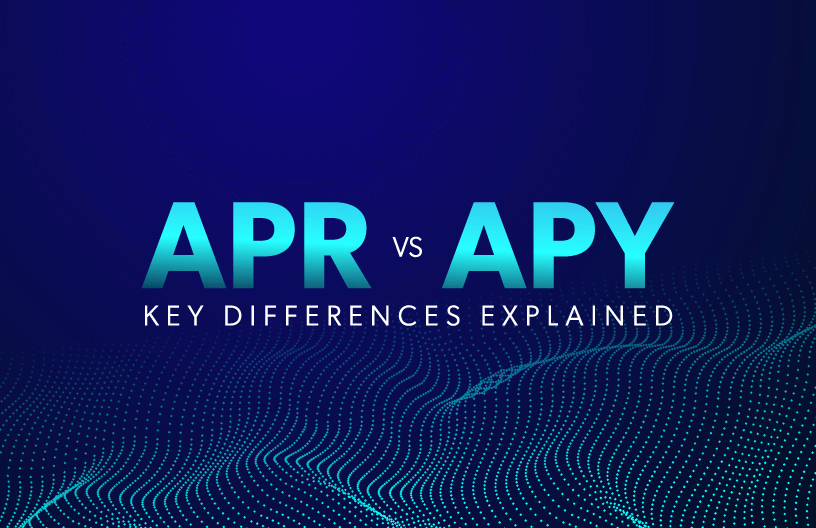

APY VS APR: Which one gives better returns?
The first question that comes to our mind when we hear APY and APR is that are APR and APY the same thing? NO. When it comes to technical terms, there is still a lot of uncertainty between APR and APY and these words are often used instead of the other.
Let us try to understand both APY and APR in-depth.
(While we clear the concept for you, make sure to give our trading platform Zelta.io a try where there is zero trading fees*, high APYs and an extensive selection of over 200 cryptocurrencies to trade.)
What is APR?
APR stands for "annual percentage rate." It is distributed annually depending on a certain amount.

APRs are connected to the expenses of capital at the conclusion of a time period. It shows you how much interest your investments will amount to after the lock-in period.
Numerous websites offer consumers a high yearly percentage return as an incentive to stake their crypto holdings. However, APR excludes compound interest from its calculations.
APR is determined by = Periodic Rate x Number of Periods in a Year.
What is APY?
APY stands for annual percentage yield which is given to users customers who loan their digital assets to investors on cryptocurrency exchanges.

APY (annual percentage yield), can also be called as cryptocurrency savings interest, because it enables users to place their crypto assets with investment companies in exchange for a return rate over a predetermined period of time.
The amount of interest payable is expressed as an annual percentage yield. Furthermore, APY takes compound interest into account.
APR vs APY - What’s the difference?
Both APR and APY impact investors and their investments. APR, however, does not account for compounding while APY pays compound interest.

Figuring out which one between APR and APY is better depends on the motive. Investment firms recommend using APR while lenders prefer APY. However when it comes to personal investments both can be considered depending on what fares better.
Those who lend money (which is what you are really doing by depositing money in a bank) or invest money want to earn the maximum rate of interest, just like those with mortgages wanting to pay the cheapest rate of interest feasible.
Investing with APR and APY
One way to make money from cryptocurrencies is by selling your investment at a higher price on the market. Other cryptocurrency income streams include staking.
Staking resembles putting money in a fixed deposit. Just like in a traditional financial bank, your deposits are lent out by banks, and you are paid interest on the outstanding sum.
APR on Crypto Staking?
Staking is a good option for people who wish to earn passive income while holding onto their assets. Staking crypto assets is a way to use your digital assets to guarantee and support blockchain network transactions.
Staking is a common method for many cryptocurrencies to validate transactions. It allows users to receive dividends on their crypto investments while also contributing to the blockchain's overall integrity.
It is now a different type of investment. As was previously mentioned, it depends on your needs.
Now that we know that there are cryptocurrencies which offer high APRs, let’s now discuss which crypto offers the highest APR.
Which Crypto offers the Highest APR?
Bitcoin and Ethereum have demonstrated one of the greatest APRs in the recent wave of investments. However, don't stop there. The quantity of crypto-assets has increased across all coins as well. Everything relies on whether you pick the appropriate cryptocurrency loan platform.
Your success will depend on elements like margin trading, cryptocurrency staking, and crypto lending. In an ideal world, you would be a platform lending assets, and as expected, your earnings would have increased over time. However, you must never lose sight of your primary objective. In other words, the return on the initial investment plus interest.
Conclusion
It's important to grasp the concepts of APR and APY to effectively handle your finances. The difference between APR and APY becomes more significant as interest compounds more often. Be aware of the various rates offered while looking for a loan, applying for a credit card, or trying to get the greatest rate of return on a savings account.
Financial organisations have several reasons for charging various rates, based on whether you're a borrower or a lender. Make sure you are aware of the prices they are quoting, then compare those to rates offered by similar organisations. You can be surprised by the disparity in the statistics, and the lowest stated rate for just a loan might really turn out to be the most costly.
If you liked this article, make sure to read locked vs flexible staking
Trade Bitcoin and 200+ other coins with 0 fees* on Zelta.io
Image Credits: idfcfirstbank; Mudrex; Fluid Finance.
